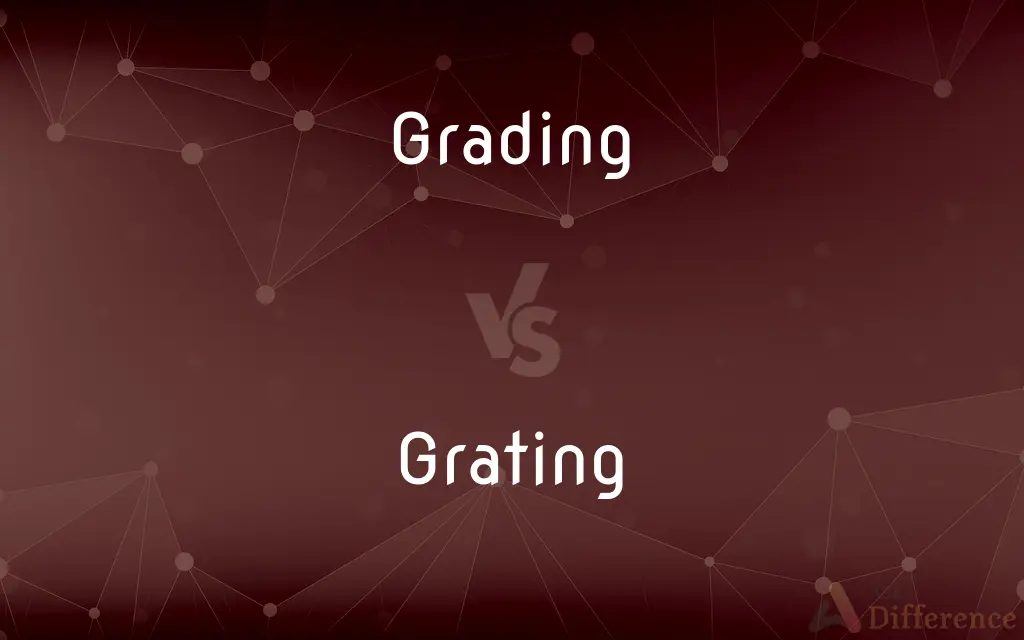Grading vs. Grating — What's the Difference?
By Tayyaba Rehman — Updated on September 30, 2023
Grading refers to evaluating or classifying by degree, quality, or rank, such as grading exams; Grating is a frame of metal bars for holding objects or a sound that is harsh and unpleasant, like a grating noise.

Difference Between Grading and Grating
Table of Contents
ADVERTISEMENT
Key Differences
Grading and Grating are terms that represent different concepts and are used in diverse contexts. Grading refers to the act of evaluating or assigning a rank or grade based on performance, quality, or criteria. It is commonly used in educational contexts where students’ work, like exams or assignments, are assessed and assigned grades based on their performance. In contrast, Grating has dual meanings; it can refer to a frame of parallel bars or a crosshatched frame, usually made of metal or wood, used to cover openings or hold objects, or it can denote a harsh, irritating sound or feeling.
Grading is an integral aspect of educational systems and other evaluative processes. It provides a standardized way of assessing performance, facilitating comparisons and identifications of areas for improvement. Grading aids in the objective assessment of work or performance, allowing for recognition of excellence and identification of areas needing improvement. On the other hand, Grating as a physical object is essential in various construction and architectural applications, providing security, ventilation, or filtration, while as a sensory experience, it represents discomfort or annoyance, often associated with unpleasant sounds or feelings.
In practical applications, Grading is used not only in education but also in categorizing the quality of products, like diamonds, or in determining the level of a land's slope in construction. It is pivotal in maintaining standards and ensuring quality across various domains. Conversely, Grating as a structure is employed for practical purposes like draining water or securing openings, and when used to describe sensory experiences, it often conveys displeasure or irritation, reflecting the negative impact of certain sounds or feelings on individuals.
While Grading reflects evaluation, classification, or leveling, contributing to standardization and quality assurance, Grating can represent either a functional structure used in diverse applications or an unpleasant sensory experience. Each term adds a distinct dimension to language, one portraying assessment and categorization, and the other illustrating functionality or discomfort.
Grading and Grating, despite their phonetic similarity, denote disparate meanings and are applied in various fields, from education and quality assurance to construction and sensory description. Understanding the context in which they are used is crucial to grasp their correct meanings and implications.
ADVERTISEMENT
Comparison Chart
Definition
Evaluating or assigning a rank or grade
Frame of parallel bars or an unpleasant, harsh sound
Context
Education, quality assurance, construction
Construction, sensory description
Application
Assessment of performance, product quality, land slope
Covering openings, holding objects, conveying discomfort
Field
Education, construction, quality control
Architecture, acoustics
Implications
Standardization, recognition of excellence, improvement identification
Security, ventilation, displeasure
Compare with Definitions
Grading
Grading is the process of evaluating and assigning a rank based on performance or quality.
The teacher spent the weekend grading the students' essays meticulously.
Grating
Grating can be a structure used for securing or ventilating purposes in construction or architecture.
The grating on the window provided both security and ventilation.
Grading
Grading refers to the categorization or leveling of quality or importance.
The grading of diamonds is crucial in determining their value.
Grating
Grating represents a functional or sensory aspect, either as a protective structure or an annoying experience.
The metallic grating was installed for safety, but the grating noise nearby was disturbing.
Grading
Grading involves the assessment and classification based on predetermined criteria or standards.
Grading of the land is the first step in the construction process.
Grating
A grating is any regularly spaced collection of essentially identical, parallel, elongated elements. Gratings usually consist of a single set of elongated elements, but can consist of two sets, in which case the second set is usually perpendicular to the first (as illustrated).
Grading
Grading provides a measure to compare and standardize performance or quality.
Grading systems in education allow for a standardized evaluation of students’ performance.
Grating
A grill or network of bars set in a window or door or used as a partition; a grate.
Grading
A stage or degree in a process.
Grating
A diffraction grating.
Grading
A position in a scale of size, quality, or intensity
A poor grade of lumber.
Grating
(typically of a voice) Harsh and unpleasant.
Grading
An accepted level or standard.
Grating
Abrasive; tending to annoy.
Grading
A set of persons or things all falling in the same specified limits; a class.
Grating
A barrier that has parallel or crossed bars blocking a passage but admitting air.
Grading
A level of academic development in an elementary, middle, or secondary school
Learned fractions in the fourth grade.
Grating
A frame of iron bars to hold a fire.
Grading
A group of students at such a level
The third grade has recess at 10:30.
Grating
The loose material that comes from something being grated.
Add a few gratings of nutmeg to the hot milk.
Grading
Grades Elementary school.
Grating
An optical system of close equidistant and parallel lines or bars, especially lines ruled on a polished surface, used for producing spectra by diffraction.
Grading
A number, letter, or symbol indicating a student's level of accomplishment
A passing grade in history.
Grating
The strong wooden lattice used to cover a hatch, admitting light and air; also, a movable lattice used for the flooring of boats.
Grading
A military, naval, or civil service rank.
Grating
The sound made by something that grates against something else.
Grading
The degree of inclination of a slope, road, or other surface
The steep grade of the mountain road.
Grating
Present participle of grate
Grading
A slope or gradual inclination, especially of a road or railroad track
Slowed the truck when he approached the grade.
Grating
A partition, covering, or frame of parallel or cross bars; a latticework resembling a window grate; as, the grating of a prison or convent.
Grading
The level at which the ground surface meets the foundation of a building.
Grating
A system of close equidistant parallel lines or bars, esp. lines ruled on a polished surface, used for producing spectra by diffraction; - called also diffraction grating.
Grading
A domestic animal produced by crossbreeding one of purebred stock with one of ordinary stock.
Grating
The strong wooden lattice used to cover a hatch, admitting light and air; also, a movable Lattice used for the flooring of boats.
Grading
(Linguistics) A degree of ablaut.
Grating
A harsh sound caused by attrition.
Grading
To arrange in grades; sort or classify
How is motor oil graded?.
Grating
That grates; making a harsh sound; harsh.
Grading
To determine the quality of (academic work, for example); evaluate
Graded the book reports.
Grating
A barrier that has parallel or crossed bars blocking a passage but admitting air
Grading
To give a grade to (a student, for example).
Grating
A frame of iron bars to hold a fire
Grading
To level or smooth to a desired or horizontal gradient
Bulldozers graded the road.
Grating
Optical device consisting of a surface with many parallel grooves in it; disperses a beam of light (or other electromagnetic radiation) into its wavelengths to produce its spectrum
Grading
To gradate.
Grating
Unpleasantly harsh or grating in sound;
A gravelly voice
Grading
To improve the quality of (livestock) by crossbreeding with purebred stock.
Grating
Grating can refer to a framework of parallel or crossed bars, used to cover an opening or hold objects.
The grating over the drain prevented any large debris from entering.
Grading
To change or progress gradually
Piles of gravel that grade from coarse to fine.
Grating
Grating also denotes a harsh, unpleasant sound or sensation.
The grating sound of metal against metal made him wince.
Grading
Present participle of grade
Grating
Grating is used to convey the irritation or discomfort caused by harsh sounds or sensations.
The constant grating noise from the machinery was unbearable.
Grading
A rank or grade.
Grading
(math) Gradation.
Grading
The act or method of arranging in or by grade, or of bringing, as the surface of land or a road, to the desired level or grade.
Grading
The act of arranging in a graduated series
Grading
Changing the ground level to a smooth horizontal or gently sloping surface
Grading
Evaluation of performance by assigning a grade or score;
What he disliked about teaching was all the grading he had to do
Grading
Grading aids in identifying areas of improvement and recognizing excellence.
Grading of the assignments helped students understand their areas of weakness.
Common Curiosities
What does Grating refer to?
Grating can refer to either a frame of parallel or crossed bars covering an opening or holding objects or a harsh, unpleasant sound or sensation.
What is Grading primarily used for?
Grading is primarily used for evaluating and assigning a rank or grade based on performance, quality, or criteria, often in educational contexts.
Is Grading only applicable in educational settings?
No, grading is also used in other contexts like determining product quality, land slope in construction, and more.
Share Your Discovery

Previous Comparison
Breeches vs. Trousers
Next Comparison
Practice vs. MethodAuthor Spotlight
Written by
Tayyaba RehmanTayyaba Rehman is a distinguished writer, currently serving as a primary contributor to askdifference.com. As a researcher in semantics and etymology, Tayyaba's passion for the complexity of languages and their distinctions has found a perfect home on the platform. Tayyaba delves into the intricacies of language, distinguishing between commonly confused words and phrases, thereby providing clarity for readers worldwide.
















































